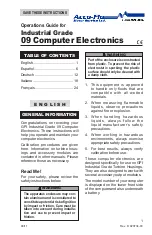
Field Calibration Necessity
Field Calibration and Factory
Calibration are defined in the
Operation Section. Factory calibration
settings are programmed into each
computer during manufacturing,
using stoddard test solvent at 70°
F (21° C). Settings are correct for
light liquids such as water, gasoline
or diesel. Readings using the
Factory Calibration (FAC) may not
be accurate in some situations, for
example, “heavy” liquids such as
motor oil under extreme temperature
conditions, non-standard plumbing
configurations or with fluids other
than those mentioned above.
For improved accuracy under such
conditions, the computer allows for
“field” calibration, that is, user entry
of custom calibration parameters. A
“single point” calibration may yield
acceptable accuracy when used in
a non-standard application.
Field Calibration
Procedures (Correction
Factor Method)
1. To calibrate, press and hold
the CALIBRATE and DISPLAY
buttons for about 3 seconds until
you see FLdCAL. Release both
buttons and you will see CF - 00.0.
You are now in the field calibration
mode and values from -99.9% to
+99.9% can be entered.
2. The +/– position appears either
as an “underscore” character for
plus, or as a “hyphen” character
for minus. The DISPLAY button
selects the position and the
CALIBRATE button toggles this
character.
3. The DISPLAY button can then
be pushed to select the numeric
positions. Press the CALIBRATE
button to scroll from 0 to 9. Enter
the percentage of change you
want the display to correct. When
satisfied with the value, press
both CALIBRATE and DISPLAY
buttons simultaneously. CALEnd
will be displayed and unit will go
back to normal operation, less the
FAC (factory calibration) icon.
4. All enabled units-of-measure
remain visible and selectable – the
entered correction will be applied
to all enabled units.
5. To return to factory calibration
(FAC), press and hold both
CALIBRATE and DISPLAY
buttons for about 3 seconds
until FAcCAL is displayed. Then
release buttons. Unit should
return to normal operation and
FAC icon is visible.
During daily use, these meters are
virtually maintenance-free. Don’t
let liquids dry inside the meter. If
liquids have dried and caked on
the rotor, clean the internal parts
with a penetrating lubricant such as
WD-40
®
or a cleaning solvent. Do not
submerge the meter. A soft brush or
small probe can be used to remove
residue from the rotor. Do not blow
compressed air through the meter.
Check the batteries and clean the
terminals every year to ensure proper
operation.
4
MAINTENANCE
Summary of Contents for 09 Series
Page 31: ......





































